The University Archives turns 70 on 3 May this year. To celebrate this milestone, check the blog at the end of each week for the week’s special stories from our collections.
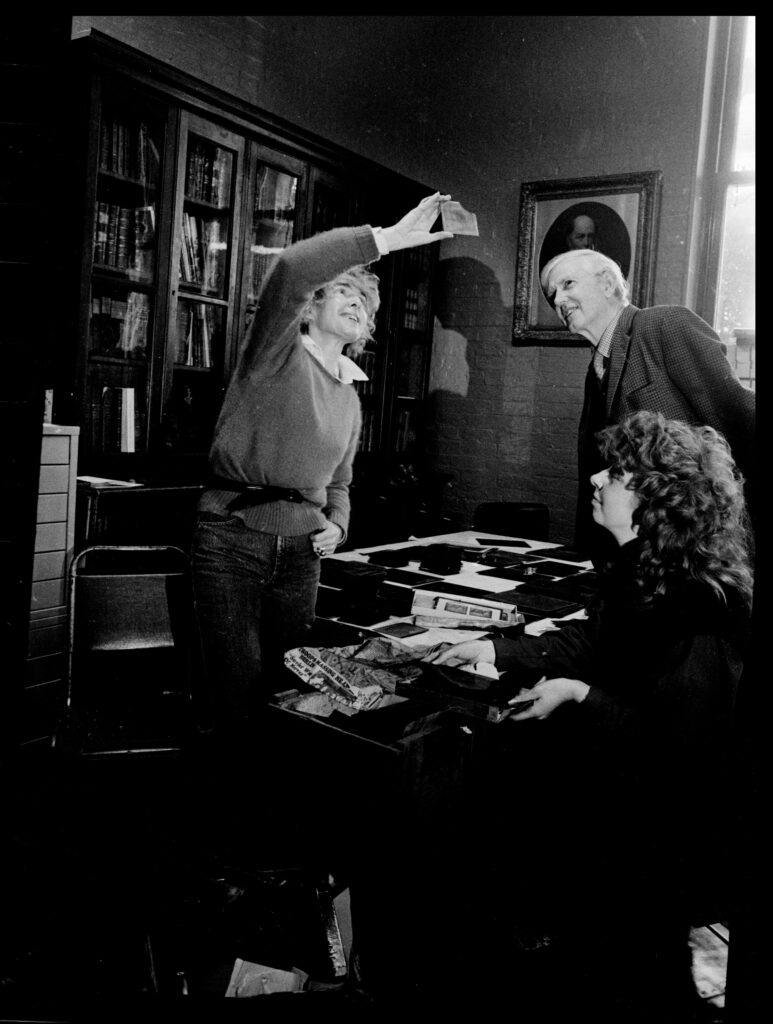
15 April 2024
The Box in the Roof
Throughout his tenure as Professor of Chemistry in the late-nineteenth and early-twentieth century, Archibald Liversidge took many photographs capturing different aspects of life at the University. In 1984, while Dr Graham Holland, retired Senior Lecturer in Chemistry, was “…ferreting around for material to contribute to [his] chapter on chemistry for the Science Faculty’s history…to celebrate the centenary…of the first Science graduation”, he came across a wooden box in the roof space of a lecture theatre in the Chemistry Building. Inside the box, delicately wrapped in newspaper, he discovered, “…200 glass negatives of a valuable nineteenth-century collection of photographs, including some previously unknown to historians”, and quickly determined them to be photographs taken by Professor Liversidge.
The negatives depicted scenes from science classrooms and lectures at the University, the Macleay Museum and other University buildings, as well as areas of Sydney and the interior and exterior of Professor Liversidge’s home, “…a most unusual house called ‘The Octagon’ at Darling Point”. For Dr Holland, the ‘lecture series’ negatives were “…of great value for deciphering the details of instruments and of words and formulae on the lecture boards. Clearer prints and enlargements can be made from the original negatives, which are eight by ten inches and in excellent condition”.
Though it was, “…not as yet known who packed the negatives”, Dr Holland and his colleagues at the Macleay Museum, Catherine Snowden and Alison Lea, did know that “Liversidge left some photographs at the University and others were returned to it after his death in 1927”. From the dates on the newspaper used to wrap the negatives (with Cold War era headlines declaring ‘Russian troops massing near Berlin’), it was determined that the negatives were boxed in 1948. From there, it was hypothesised that the, “…boxes must have been moved into the Chemistry Building in 1959 from the present Pharmacy Building, which was built under Liversidge’s direction to house Chemistry and the School of Mines”.
This photograph depicts Dr Holland, Snowden and Lea examining the negatives. Following their discovery, and with permission from the Head of the Chemistry School, Associate Professor Don Napper, the negatives were donated to the Macleay Museum’s Historical Photograph Collection. There, they were “…professionally cleaned and stored by Miss Alison Lea, under Ms Snowden’s direction”.
Alison Lea, Catherine Snowden and Dr Graham Holland Examining Liversidge Negatives at the Macleay Museum (1984), [REF-00012453]. University of Sydney Archives, accessed 15/04/2024, https://archives-search.sydney.edu.au/nodes/view/30906.
16 April 2024
The Holy Stole
Sir Hermann David Black’s association with the University began in 1927 when he graduated with a Bachelor of Economics (Honours Class I, University Medal, Chamber of Commerce Prize, F Albert Prize). After holding various positions within and outside the University, Sir Black was elected Chancellor. On 4 May 1970, Senate reported, “Following the death of the Chancellor, Sir Charles McDonald on 23rd April, 1970, the Senate proceeded to the election of a Chancellor…Mr. Black (Deputy Chancellor) was nominated…Mr. Justice Le Gay Brereton was also nominated…A ballot was held and the Vice-Chancellor declared Mr. H.D. Black elected as Chancellor…The Chancellor expressed his thanks for the confidence which the Fellows had placed in him. He said that it was his boundless desire to serve the University and in this he asked the Fellow for their help, their counsel and their criticism”. The 1 June 1970 University of Sydney News featured the election on the front page, listing Sir Black’s many professional achievements and roles, including noting that, “Mr. Black…is well-known publicly as a radio and television commentator on political and international affairs”.
During Sir Black’s almost twenty-year tenure as Chancellor, he was unsurprisingly involved in many social events, such as the Dalai Lama’s visit to the University in August 1982. The 29 June 1982 University of Sydney News announced that, “The Dalai Lama, the spiritual leader of Tibetan Buddhists, is to participate in functions at the University in August, during his visit to Australia. The Dalai who lives in exile in India, will give a public lecture on Buddhism in the Great Hall from 2.30 to 4pm on Saturday 14 August. The following day, Sunday 15 August, from 10-12am [sic], he will take part in a general discussion of issues stemming from the mind/brain relationship”. This white, fringed stole was presented to Sir Black during this visit, who retained it as a memento and ultimately transferred it to the University Archives along with his other personal papers.
Sir Black stepped down as Chancellor in 1990, which was reported by the University of Sydney News on 20 February 1990, “The Chancellor, Sir Hermann Black, has told Senate that, because of his state of health, he is unable to perform his duties in an appropriate manner and in a way which the University is entitled to expect…Sir Hermann was first elected to office in May 1970. He was last re-elected in 1988. Senate asked that its good wishes be conveyed to Sir Hermann through Lady Black”.
Stole Gifted by the Dalai Lama to Chancellor Sir Hermann Black (No Date), [REF-00089519]. University of Sydney Archives, accessed 16/04/2024, https://archives-search.sydney.edu.au/nodes/view/142378.
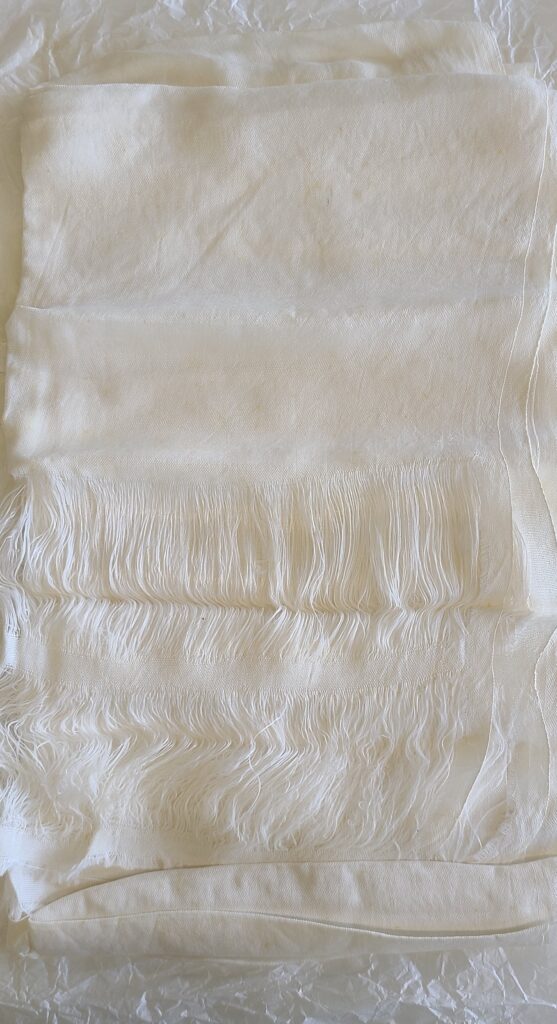
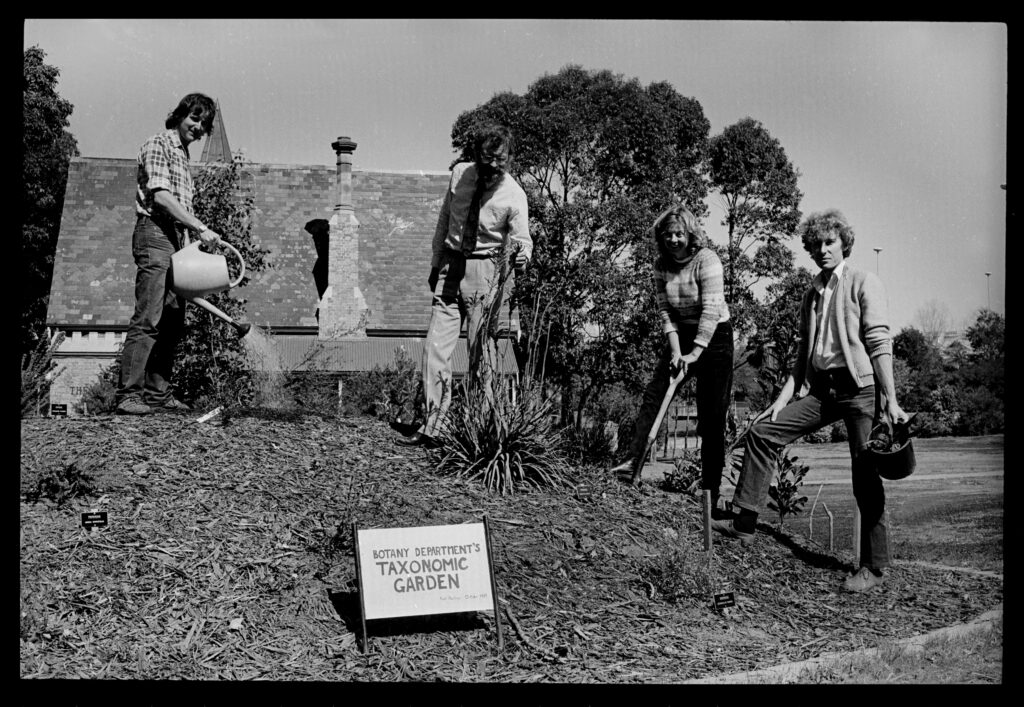
17 April 2024
The Classification C Garden
The Standing Committee of Convocation, on 26 September 1972, heard from Miss [Alison M] Turtle who, “…raised the question of the proposed demolotion [sic – demolition] of Darlington Public School by the University to make way for a new Biological Sciences Building. After some discussion, it was resolved: “That information be sought from the Buildings and Grounds Committee on the proposed plans for the Darlington Public School, especially the building which has been entered on the register of the National Trust and that the National Trust be asked for the reasons for its ‘C Classification’ of this building”. Turtle had contacted the National Trust of Australia on 28 July 1972 who wrote that, “…the Trust Council on the recommendation of its Historic Buildings Committee has resolved that the Darlington Primary School be including in the Trust’s Register of Historic Buildings with the classification of “C”. Buildings so classified are defined as being of considerable interest and their preservation is recommended…Classification by the Trust does not have legal force but it is recognised as an authoritative statement of the historical and/or architectural significance of a building”. The Standing Committee of Convocation noted at its next meeting on 28 November 1972 that, “Miss Turtle briefly outlined the proposed building operations on the site of the Darlington Public School, and urged the Standing Committee to use its influence to preserve the most important of the school’s buildings. The Standing Committee then resolved to convey to the Senate its opinion that the building of the Darlington Public School which is closest to Darlington Road, is one which should be preserved by the University, and requests that the Senate, in considering plans for the redevelopment of that area, give priority to plans which will allow for the incorporation of that building”.
The matter was first referred to the Buildings and Grounds Committee and considered on 23 February 1973, “Mr. McInnes advised the Committee that the oldest parts of the school had been built in 1877 and 1882. The Committee discussed the architectural merits of the school and generally agreed that there did not appear to be a case for preserving it. Professor Johnson suggested an attempt should be made to find out why the Trust had given it a B [sic] classification”, however, went ahead and, “…resolved to report to the Senate as follows: “Having considered the reference from the Senate about the opinion of the Standing Committee of Convocation that the building of the Darlington Public School which is closest to Darlington Road should be preserved, the Committee reports that it believes that if the buildings, which are of different dates and the oldest of which is in a poor state of repair, should interfere with the proper development of the site for Biological Sciences, it does not believe that they should be retained.”. This was communicated to Senate on 6 March 1973 and adopted.
This decision was made while the University faced considerable backlash from the local community, who formed a Chippendale/Darlington Action Group, and organised a, “…campaign to save your environment for you…protesting against the University’s unnecessary and destructive expansion into Darlington and Chippendale”. Their circular, which attached three letters intended for members to sign and send to the South Sydney Council, the University and the Commonwealth Government, stated, “Help save your homes!!! The expansion of the University of Sydney threatens to destroy your suburb”. The letter addressed to the University read, “I am extremely concerned that the plans for the continued University of Sydney expansion are a serious threat to the present community. Your new buildings…and your chain-wire/barbed-wire fences are offensive in such a well established, long settled residential area. There is a need for a University in the Western Suburbs. Isn’t your University too big already? Should it expand further when its present site is not fully developed? Should it expand at all at the cost of totally destroying yet another inner city suburb?”.
A report titled ‘The University Expansion into Chippendale-Darlington’ noted, “The building would be four storeys and sixty feet high, rising off a podium and would have adjacent one and one-third (1-1/3) acres for a taxonomic garden…In reply to a question about the need to demolish Darlington Public School, “Mr Grainger”, for the architects, “advised that it would be possible to retain the main part of the school if the University desired to do this”. The building still stands today, and the School got its Taxonomic Garden as promised.
Botany Department’s Taxonomic Garden Near the Old Darlington School (1984), [REF-00012464]. University of Sydney Archives, accessed 17/04/2024, https://archives-search.sydney.edu.au/nodes/view/30918.
18 April 2024
A Chair in Thuggery
On 5 May 1969, Senate discussed the matter of the “Disturbances within University on 1st May, 1969”. The minutes noted that, “The Vice-Chancellor referred to the demonstration and disturbances on the afternoon of 1st May, 1969 in the presence of the Governor of New South Wales who in extremely difficult circumstances had inspected a guard of honour provided by the Sydney University Regiment before attending a Ceremony of Conferring of Degrees at which he gave the occasional address. The Vice-Chancellor informed the Senate that he had appointed a Committee to report to him on these disturbances and on the events leading up to them…The Committee had already held its first meetings to hear reports from those who had witnessed the disturbances or who had knowledge of the events leading up to them”.
One such report was received from Jim Spigelman, President of the Students Representative Council (SRC), who wrote that, “At lunch time on the 30th April a meeting was held in the front lawn to announce plans for a demonstration against the Sydney University Regiment…the protestor group intended to sit down in the path of the Regiment allowing it to avoid the demonstrators or to march into them. This sit-down, it was asserted, would be the only action taken. On May 1st the meeting called by both the Labor Club and S.D.S. [Students for a Democratic Society] began in a frivolous manner which unfortunately, failed to set the tone for the afternoon’s events. Ross Clark, dressed in mock military outfit, presented an amusing imitation of the Governor or to be more exact, the Governorship. The person of Sir Roden Cutler was not the basic theme of Clark’s send-up. Towards the latter part of Clark’s speech a barrage of fruit, milk cartons and flour bombs etc. began from a group in front of the speaker and to his right. The core of the left wing groups, S.D.S. and the Labor Club, were behind the speaker to his left. Any of the missiles which missed the speaker at the microphone thus landed in the midst of the radical group. After a while individuals in the radical group began picking up the fruit and throwing it back to the anti-protestor group. May I point out at this stage that Percy Allen, who delivers the “Daily Bull” to the Engineering School, saw signs at the School on the night of April 30th stating that “Democrat” invites Engineers to the front lawn meeting and asking them to bring fruit and other missiles. The crucial incident which accentuated the existing tension occurred during the speech of Mike Jones. Two students from the anti-protestor group approached the speaker with a garbage can half full of water…a scuffle broke out, punches were thrown and the crown surged forward…I suggested that the demonstration against the Regiment be called off…I questioned the legitimacy of civil disobedience tactics within the University, especially when proper democratic procedures had been ignored. In reply to my suggestion, it was argued that the Regiment should similarly call off its march…Unfortunately some members of S.D.S. and the Labor Club did not stick to their plan which was limited to a sit down in front of the Regiment. This led to a continuation of the scuffles between the two groups of students resulting in the unfortunate public image of a violent demonstration against the Governor…Instead of disbanding when their point had been made by sitting in front of the march, some members of the group continued their “protest” at the inspection of the guard. In this way the Governor became the centre of the continuing storm…Neither of the two contestant groups is wholly to blame and both must bear the responsibility for a series of events which has brought discredit to the entire student body”.
The student body and the University in general was certainly discredited, sometimes vociferously, as members of the public felt offended enough to write in to the University. A lettergram was received the next day, on 2 May 1969, “If you do not have the courage to exprell [sic] those who indulted [sic] his Excellency and inferentially Her Majesty you [the Vice-Chancellor] ought to resign”. The Reverend from the Missionaries of the Sacred Heart wondered whether, “Will they [those responsible] be given the opportunity to stage similar insulting demonstrations in the future? I write this protest in the hope that many similar protests will help to ensure that our Universities maintain a fitting discipline & promote a true love of democracy”. Commander CG Little made his disappointment known, “As an ex member of the defence forces of this nation, a taxpayer, and one of those whose father and grandfathers helped to build up this country, I am shocked at the violence, disorderly conduct, and utter lack of discipline evident in your university, resulting in the shameful attack yesterday on our Governor. Have the university Council no pride in their establishment at all? It is considered that these louts responsible are utterly unsuited for tertiary education, and should be expelled…Why, Sir, yesterday with a “guard” present could not this body be used to quell these barbarians, and defend the Governor, who, I might remind you is the head of this democratic [underlined] state? Some action is needed, drastic and immediate, if we citizens are to be reassured, otherwise “those who pay the piper” may start calling the tune!”. Ken Martin, a recent alumni, noted that, “Political comment on the campus is lately sinking to the banal level…It is wrong that students should be free to act like louts and go unpunished, for in no other sections of the community – factory, office, school, dockside or farm – is riotous behaviour tolerated. I write this appeal to you for a firmer hand…it seems to me a great shame to see the reputation of an old university being undone”. Other letters continued in a similar vein. J Marshall provided the University with a proposal, “In view of the events of last week, I suggest you institute a chair in thuggery. It would appear that a large number of your students would have no difficulty in passing with first class honours”.
At its 5 May 1969 meeting Senate approved, “…that an appropriate message be conveyed to His Excellency the Governor expressing the very great regret of the Senate that he had been subjected to such indignity during his visit to the University…also include a statement that the Senate anticipated with pleasure his next visit…The Deputy Chancellor suggested that the letter be conveyed personally to the Governor”.
Incident Between Activist Students and University Regiment During Inspection by Governor Sir Roden Cutler (1969), [REF-00054999]. University of Sydney Archives, accessed 18/04/2024, https://archives-search.sydney.edu.au/nodes/view/78949.
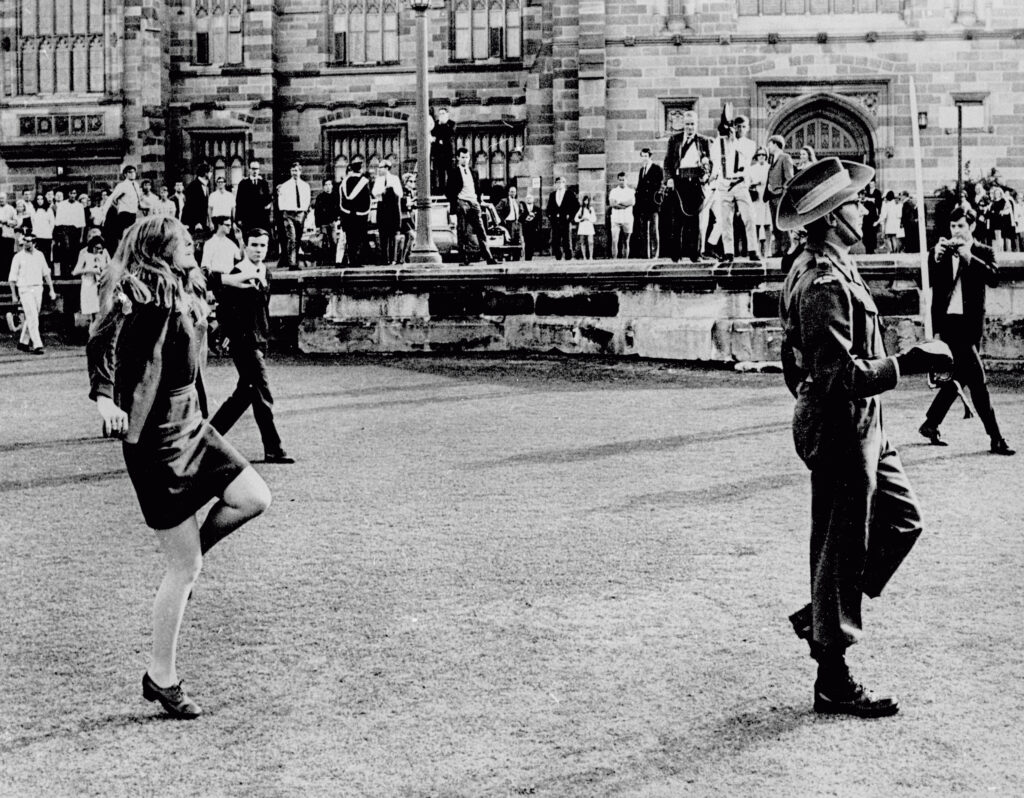
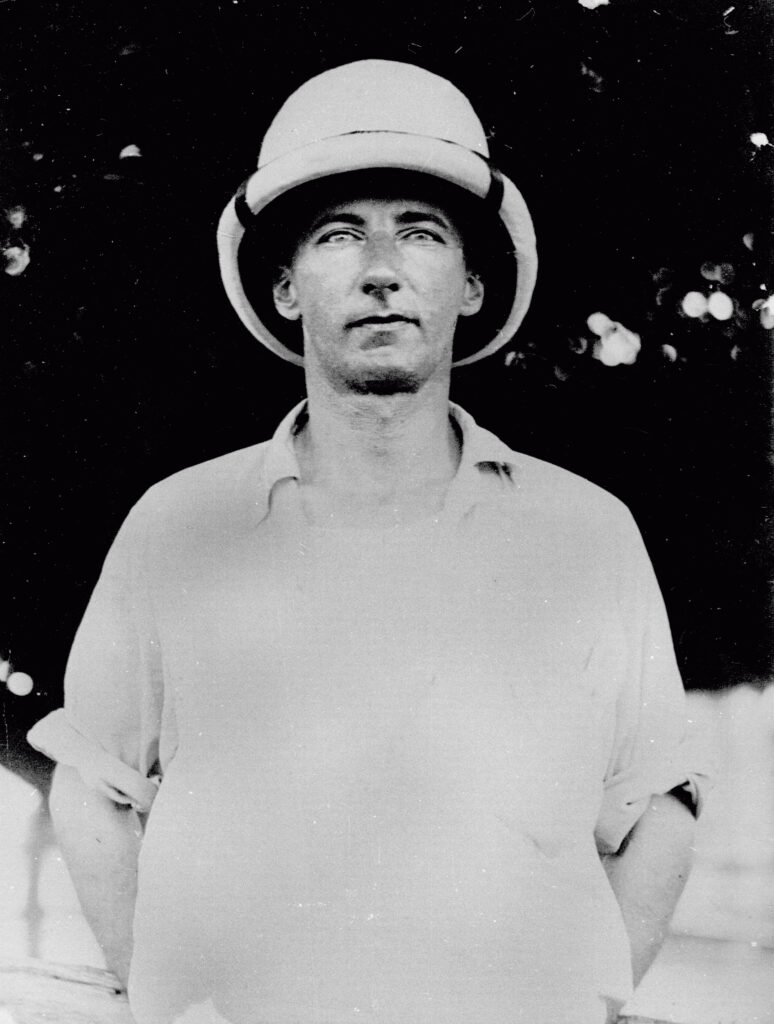
19 April 2024
The Trousered Man
Professor of Anthropology, Professor Adolphus Peter (AP) Elkin, was an undeniably busy man. Among his many responsibilities both within and outside the University, Professor Elkin was also a member of various committees of the Road Safety Council of New South Wales in the 1940s and 1950s, despite regularly missing meetings due to multiple competing commitments. As Chairman of the Council’s Technical Research Subcommittee, however, he noted on 31 July 1950 that, “Actually, I don’t think I belong to this Sub-Committee, although I was asked to be a member of it. I attended an initial meeting and realised that there was no real way in which I could help. If real research into the problem was arranged, I could with a team, get busy, but apart from that there is nothing much that I could do…I have, however, read through the draft proposals and am very much in favour of the stiffening of penal sanction in connection with driving offences, especially those where culpable driving and drink are concerned, and, of course, anything that helps to educate the public is of value, though the real problem is with people who require very definitely shock treatment”.
The matter of road safety was one Professor Elkin clearly felt passionately about, as on 15 October 1948, he wrote to the Council, “The two main points I endeavoured to make while on the Committee dealing with research are still important :- (i) that the unsatisfactory picture of road accidents cannot be considered alone; it is part of the general picture of social ill health of the community, the causes of which are only partly to be found in the war situation. Our society is in the process of rapid change and thus unsure of itself; whole values are being disregarded and old standards being thrown overboard. This tends to cause a disregard for society’s rules and regulations and to lessen respect for human personality. (ii) My second point has been that shock treatment is required and I emphasise again that this does not mean horror treatment, but realisation of the facts and getting drivers to realise the facts. Killing people is killing people even though it be done by mudguards of a care…These are not the days to squeamish about telling people these facts. Unfortunately, the word “courtesy”, on which so much emphasis is placed, belongs rather to the chivalry and knighthood of the Middle Ages, and in any case will not bring people up in that sharp tone which is required in these days”. Professor Elkin prepared statements and reports along this vein and ultimately contributed a new sign to the Standards Association of Australia, as reported in a newspaper article, “A new symbol, to denote a pedestrian crossing, had been recommended by the association. The symbol is a pair of trousered legs walking over a marked foot crossing. The sign was proposed by the chairman of the Road Signs and Signals Committee, Professor A. P. Elkin, who saw a similar symbol in Ceylon – that of a coolie walking over a crossing. The association considered this sign more arresting than the sign of the “mechanical man” proposed by the United Nations”.
Adolphus Peter Elkin, Professor of Anthropology, as a Young Man (Circa 1930), [REF-00053083]. University of Sydney Archives, accessed 19/04/2024, https://archives-search.sydney.edu.au/nodes/view/79472.
Explore the blog for other posts from the University of Sydney Archives and follow us on Instagram.